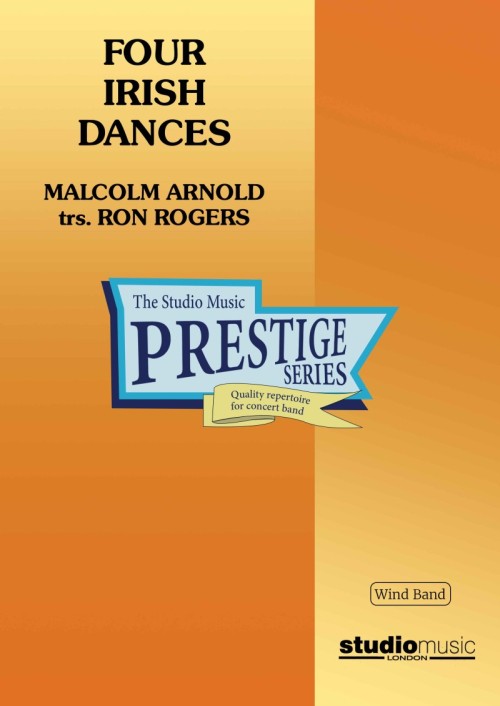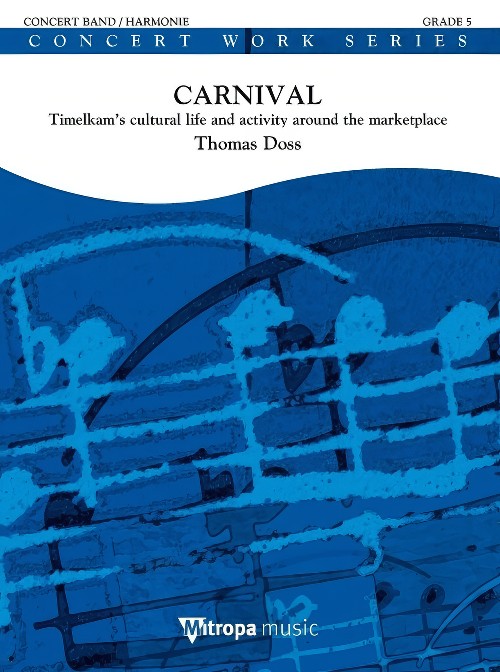Results
-
 £127.30
£127.30Ballade fra Fantasistykker for Piano op. 36 - Agathe Backer-Grøndahl
Agathe Backer Grndahl's 'Ballade' can best be described as a Romantic character piece. Such one-movement piano pieces with titles that loosely indicate a mood/idea made out a central genre in the 19th century. In Backer Grndahl's production, several of these are grouped under the term 'fantasy pieces'. There are six collections with a total of 48 fantasy pieces on her opus list and 'Ballade' is from the first of these (Op. 36), published in 1895. 'Ballade' is a broader work than the other fantasy pieces. It is built around a dramatic theme that keeps returning after episodes with strongly contrasting thematic material.The arrangement is close to Backer Grndahl's original composition. It is transposed a semitone down: from E flat minor to D minor. The arrangement contains some challenging passages and is well-suited for amateur bands of a certain level. The instrumentation makes no special demands beyond normal concert band instrumentation and will sound just as good in small as in large bands.
Estimated dispatch 7-14 working days
-
 £199.99
£199.99Fanfare No. 1 - Wataru Hokoyama
Fanfare No. 1 (1995) In the summer of 1995 before his departure to the United States, a request from his high school band friends for a good concert opener sparked 19 year old Hokoyama to write his very first wind band composition.To capture the excitement of the rising curtain, the piece begins with magnificent brass ascending in 4th and 5th intervals. This is followed by the energetic entrance of the full ensemble like celebratory cannon fire. The following melody has many notes, yet is still simple. Do not overestimate it, just perform with driving momentum.In the slower middle section, utilize an instinctive vision of a scorching midsummer sun shimmering on the horizon. (Likely this shimmering sunset image was scored unconsciously, being composed in midsummer. A more applicable mood might be "Indian sunset". Perhaps this Indian style came from a capricious feeling of youthfulness.)The bright tempo and melody return for the last section. The climactic volley of musical display is like explosive fireworks as the last sounds echo throughout the concert hall.The composer wishes for performers to play from their hearts and not be limited by an analytic approach to the score-absolute accuracy is not required. Above all, the deepest pleasure for the composer is to know that teachers and students share the joy of music making with the intention of sharing it with others all over the world.With deepest gratitude, thank you for performing this work.
Estimated dispatch 7-14 working days
-
 £141.99
£141.99Jalan-Jalan - Shin'ya Takahashi
Jalan-jalan was inspired by the music of Bali, Indonesia based upon its unique melodies, modes and rhythms. As part of the independent archipelago "Ryukyu", Okinawa (southernmost Japan) had an active exchange with Bali that included cultural and musical influences. Jalan-jalan means "walkabout" or "walking journey" in Indonesian. It describes a walk in the so-called Isle of the Gods, encountering Bali's beautiful scenery and daily life. Its four themes include "Dawn," "Morning Market," "Beach in Early Afternoon" and "Kecak Dance (a form of Balinese dance and music drama, performed primarily by men) in Torchlight."An imposing pesante introduction will properly establish this song's mood. Boldly balance winds and percussion to the prominent timpani solo. At Allegro Vivo, observe the lighter abbreviated scoring and balance melody/countermelody at E. Melodies are elongated at the Grazioso, and tenor/bass rhythm figures need enough separation to be felt. The urgent-feeling Presto must initially be reserved except for the percussive "slaps"; same thing again at O. The daunting rhythmic figure at Q is actually a chattering effect-combine the two elements to teach continuity and placement. Don't "over blow" the ending, but continue to emphasize unique rhythmic elements.(Shin'ya Takahashi)
Estimated dispatch 7-14 working days
-
£109.99
Metalla - Jan van der Roost
Metalla was commissioned by the 'Kreisverband Altenkirchen' of Germany and dedicated to Ottomar Jung. The composer himself conducted the premiere of the piece, which was performed by the 'Jugendorchester Kreisverband Altenkirchen' on 25 March 1999.The region of Altenkirchen is known for its iron mines, which find musical expression in the dark mood of the introduction (andante misterioso). This effect is accomplished with overlapping seventh intervals, orchestral crescendos, a succession of broad chords and the presentation of most themes in the middle register of the band.The dynamic section (allegro energico) that follows the introduction is characterized by concise figures inthe brass and a second motif, a kind of rippling motion depicting the Sieg River, an important element in the landscape of the Altenkirchen region.The work closes with a final theme that returns a number of times, albeit in different guises. After a brief repeat of the seventh intervals from the beginning, a last radiant chord signals the end of the piece.
Estimated dispatch 7-14 working days
-
 £149.40
£149.40Tenn Lys - Eyvind Skeie
"Candles in Advent" is a beautiful melody with great lyrics. It was originally written for an Norwegian Advent TV-series in 1985.In this arrangement, the oboe has some solo passages (cue notes in flute). I Have tried to vary the instrumentation without going beyond the beautiful Christmas mood.The harmonization is simple and functional. Let the soloists "speak" with good phrasing and focus also on harmony in the unison melody lines. Good balance and intonation in the accompaniment can make the performance a little gem on the Christmas concert.- Reid Gilje -
Estimated dispatch 7-14 working days
-
 £168.50
£168.50Psalm for Band - Vincent Persichetti
Psalm for Band is a piece constructed from a single germinating harmonic idea. There are three distinct sections - a sustained chordal mood, a forward moving chorale, followed by a Paean culmination of the materials. Extensive use is made of separate choirs of instruments supported by thematic rhythms in the tenor and bass drums. Psalm was selected for performance at the CBDNA Convention in December 1952 as one of the eight most outstanding compositions for band written in the previous several years. Theodore Presser Company editor Daniel Dorff, on the new Centennial Edition, explains, "The 1954 Elkan-Vogel publication had a full score in a calligrapher's hand that was quiteaccurate, and a set of parts that was problematic in readability and accuracy. The present 2015 edition is faithful to and compatible with the original published score, with carefully and cleanly prepared parts bearing cues, easy page turns, and individual parts for each player."
Estimated dispatch 7-14 working days
-
 £112.95
£112.95Four Irish Dances (Prestige Concert Band - Score and Parts) - Arnold, Malcolm - Rogers, Ron
Malcolm Arnold's Four Irish Dances are from the latter stage of his career. The 1986 piece complements his other regional dance suites for orchestra, including Cornish, English and Scottish dances, though it darker in mood and colour. Stomping brass and drums in the opening Allegro con Energico give way to two spare middle movements: a Comodo made from anguished melodic imitation and a lilting Piacevole with eerie solo piccolo and miniature trio for trumpets. The 11 minute piece concludes with a wild, contrapuntal jig in triple time.The original orchestra version of the work was premiered at the Leeds Castle Festival on 10 October 1987, by the Wren Orchestra conducted by the composer.
Estimated dispatch 7-14 working days
-
 £22.95
£22.95Four Irish Dances (Prestige Concert Band - Score only) - Arnold, Malcolm - Rogers, Ron
Malcolm Arnold's Four Irish Dances are from the latter stage of his career. The 1986 piece complements his other regional dance suites for orchestra, including Cornish, English and Scottish dances, though it darker in mood and colour. Stomping brass and drums in the opening Allegro con Energico give way to two spare middle movements: a Comodo made from anguished melodic imitation and a lilting Piacevole with eerie solo piccolo and miniature trio for trumpets. The 11 minute piece concludes with a wild, contrapuntal jig in triple time.The original orchestra version of the work was premiered at the Leeds Castle Festival on 10 October 1987, by the Wren Orchestra conducted by the composer.
Estimated dispatch 7-14 working days
-
 £159.99
£159.99Carnival (Concert Band - Score and Parts) - Doss, Thomas
This work was commissioned by Marktmusik Timelkam to celebrate its 170th anniversary. It describes the cultural life and hustle and bustle of the band's home base, the Austrian town of Timelkam. Carnival pictures a festive procession starting at the marketplace and lasting well into the night. The work features many carnivalesque elements and is a joy for players to perform. There is a lot of merry activity going on in the music; people cheerily chatting in the inn; singing and dancing together and having fun. There is also room for a melancholy mood, accompanied by reminiscences about eternal goodbyes and searching for love. With the added musical representation of children's playing and pranks, a beautiful sunrise as well as a depiction of the churches and societies in town, this composition is not just an account of a carnival parade but a small portrayal of life.Duration: 11.30
Estimated dispatch 7-14 working days
-
 £164.99
£164.99A Centennial Journey (Concert Band - Score and Parts) - Sparke, Philip
A Centennial Journey was commissioned by the Norwegian ensemble Stavanger Musikkorps av 1919 to celebrate their 100th anniversary in 2019. The work was premiered under conductor Morten E. Hansen at their Jubilee Concert in the Stavanger Konserthus on 28th September 2019. The piece opens dramatically with a sweeping melody on horns and saxophones under florid woodwind figuration, building to a majestic climax. A trio for the trombones calms the mood until the opening melody returns in a gentler style, eventually building to a busy molto vivo. The woodwind figuration continues over a series of brass trios until the main theme of the work appears on clarinets and euphoniums. This develops to introduce a change of key, featuring a long, hymn-like melody on clarinets and horns. The melody is then taken up by the full band, interspersed with sporadic brass fanfares. The opening of the molto vivo returns and leads to a return of the opening horn melody, building to a thrilling coda based on previous melodic material. Duration: 8.45
Estimated dispatch 7-14 working days
